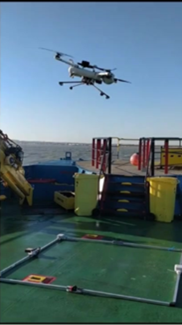Using radar to land a UAV on a bessel – how hard can it be?!

Steve Clark
We set out in 2020 with a simple aspiration - to build micro-radars to help with autonomy in the burgeoning drone market. We had 25+ years of radar expertise in other sectors, such as automotive; the challenge was to make them small and light enough for deployment on airborne UAVs.

After much deliberation and experimentation, we hit on an idea for enabling UAVs to precision land autonomously. It involved the ‘co-operation’ between multiple radar devices – one ‘Primary’ radar on the UAV itself and three corresponding ‘Secondary’ devices on the ground to form a landing pad. Our ARC solution enabled data exchange between the Primary and Secondaries providing range, elevation, bearing and altitude via a unique comms channel over which we could also add CONOPS and orientation information. This would allow UAVs to land in adverse weather and GNSS-denied conditions, providing extra resilience to existing computer vision methods and negate the need for supporting ‘spotters’ whilst landing.
We patented our solution and readied ourselves for the inevitable surging sales. Perhaps we could present and manage the radars from an online catalogue? Wrong!
Our customers did not necessarily want a radar – they wanted a landing solution, a PROVEN landing solution. And that involved integrating the radar to various UAVs and showcasing that it could then actually land. But we weren’t UAV pilots, and we did not own any UAVs….
And that was just the beginning of the journey!
It subsequently transpired that there was a range of customers with varying requirements:
- Can one landing ‘pad’ support multiple UAVs and vice-versa?
- Can the UAV land on a moving vehicle?
- Can the UAV follow a moving vehicle, not land – tethered using the radar positional data?
- Can the UAV be ‘tethered’ at an offset to the moving vehicle, i.e. not directly above?
- Can the UAV land on a moving vessel at sea?
Notwithstanding the additional development required to support the above, in which we eagerly invested, this presented two major problems. The first, was that our radars reliably provided positional data that was then passed into the host flight controller or autopilot to effect manoeuvring of the UAV. But there were several different autopilots that had many configuration settings that handled moving precision landing differently, and which were sensitive to the particular UAV’s aerodynamic characteristics. And, despite assertions to the contrary, few of our early customers had sufficient autopilot expertise in the area of radar-based precision landing – so we had to become experts in that, too. The second hurdle was that of testing; we did not have ready access to ocean-going vessels!
The corollary of this meant that we needed the support of partners that had high-performant UAVs and access to test vessel landings. Plus, a strong nerve, given that the cost and impact of a UAV crash into vessel infrastructure was not only damaging to one’s reputation! Particularly, as fine-tuning the autopilot configuration parameters can yield some apparent instability, or ‘wobbling’, of the UAV during its descent, until the correct settings are achieved.

But it didn’t end there. We were then exposed to the CONOPS of vessel landing - can the UAV approach the vessel from any direction, whilst the vessel is underway and potentially travelling in another direction, whilst pitching and rolling?
The conclusion being that safe vessel landing at sea is actually quite tricky! And cannot be solved in isolation by an SME of innovative radar experts operating out of industrial premises in Cambridge.
The MoD advocates that “.. we don't have the luxury of working out how many years or decades to bring a new technology to service. We’re certainly seeing in Ukraine that you might have weeks or months to work out how to bring that technology [into service].”[1]
So, new technologies need to come into service quickly and often need to be refined based on operational requirements and CONOPS, which can be an iterative and collaborative process. Like a lot of UK SMEs, we are part of a wider solution rather than being a stand-alone product. Although we have evolved as a business, and are no longer just radar experts, we need the support of partners – their drones, access to testing, access to vessels, real-world requirements - to evolve our products to be robust for the market and real users.
And this is where the MoD can help.
For defence, the MoD can provide support and be the lead to facilitate testing and collaboration in real-life scenarios. To seek out innovations on their individual merit rather than top level capability requirements alone. The MoD could facilitate and nurture a Sovereign DefTech ecosystem with minimal funding, deployed alongside low/no cost access to test resources. They could encourage partners/users to be open to the unknown and accept that products may not be perfect ‘out of the box’.
It is through such collaboration that innovative technical capability can meet high-level operational need. We are willing to use our technical expertise to tailor solutions to meet operational requirements, rather than vice-versa. Plus, we are agile; we can iterate solutions and revisions fast – way faster than incumbent ‘prime’ contractors. Which means that pioneering technology can be realised in operational scenarios rapidly.
Our radar catalogue notion may be but a fantasy but if the MoD can stimulate collaboration, then delivering essential operational drone capability to the frontline in an acceptable timeframe could easily become a reality. And drones can land safely, in adverse weather and in GNSS-denied scenarios, autonomously, and without the need for supporting visual ‘spotters’.





